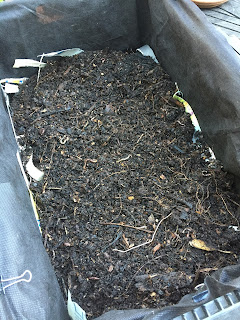It worked great! We were limited by the diameter of material the machine would grind up, but otherwise we shredded a large pile of green debris and set aside the thicker branches for the city compost bin. It's an electric grinder, so I'll be curious to see our next eclectic bill. I was wishing we already had solar panels so I didn't feel so guilty about using it, but it really made a huge difference in the quality of the material we were planning to compost. Surface area is the key to breaking material down quickly, so by shredding it the microbes will be able to get to work faster!
Then I needed to find something to contain the green debris. I'm still looking for a stackable compost bin, or something more animal-proof so we can compost our food scraps, but this old dog crate will work for now. I layered in the shredded vegetation and watered each layer. I have more material ready to grind up and add to the bin and I'm hoping to start generating usable compost in the next 3-4 months!
Then I needed to find something to contain the green debris. I'm still looking for a stackable compost bin, or something more animal-proof so we can compost our food scraps, but this old dog crate will work for now. I layered in the shredded vegetation and watered each layer. I have more material ready to grind up and add to the bin and I'm hoping to start generating usable compost in the next 3-4 months!

I also wanted to get the worm bin going. Worms can't make as much compost as a bin, but the quality of vermicompost can't be beat. To get it started, I found a friend with extra worms (you can also buy them at garden centers or mail-order them), lined a bin with a slatted bottom with landscape fabric, and shredded up newspaper for bedding. Then I moistened the newspaper and added the worms.
I gave the worms some food, in case they were hungry after their journey- you have to be more selective about what you feed the worms. No citrus, onions, or mangos and of course no dairy/meat/oils etc. So I set aside some kale leaves, arugula, apple cores, and coffee grounds and spread this around on top of the worms. Then I added another layer of damp newspaper and put a cover on the bin. Hopefully, the worms are happy in there and enjoying their new home! I put some bricks on the cover to keep out curious or hungry racoons or rats or ...? and put the bricks over the vents to keep too much rainwater from getting in the bin. The worms like it damp, but too much water will drown them. Eventually, the worms and their compost will fill the bin and I'll add a second slatted bin on top. As you feed the worms in the second bin, they are supposed to migrate up and leave you a worm-free bin of compost to use! The plants will be so happy :)
I gave the worms some food, in case they were hungry after their journey- you have to be more selective about what you feed the worms. No citrus, onions, or mangos and of course no dairy/meat/oils etc. So I set aside some kale leaves, arugula, apple cores, and coffee grounds and spread this around on top of the worms. Then I added another layer of damp newspaper and put a cover on the bin. Hopefully, the worms are happy in there and enjoying their new home! I put some bricks on the cover to keep out curious or hungry racoons or rats or ...? and put the bricks over the vents to keep too much rainwater from getting in the bin. The worms like it damp, but too much water will drown them. Eventually, the worms and their compost will fill the bin and I'll add a second slatted bin on top. As you feed the worms in the second bin, they are supposed to migrate up and leave you a worm-free bin of compost to use! The plants will be so happy :)





